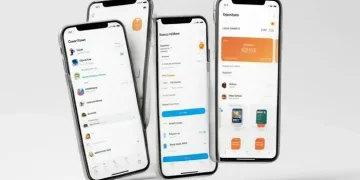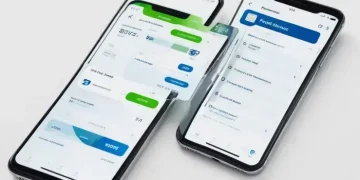Online checking account: why it’s the smartest move for your money

Thinking about switching to an online checking account? You’re not alone. With perks like lower fees, instant access, and smart tools, it’s no wonder more people are ditching traditional banks. Let’s dive into why this might be the best move for your wallet.
What is an online checking account?
An online checking account is a digital bank account that lets you manage your money without visiting a physical branch. Unlike traditional accounts, it operates entirely through a website or mobile app, offering features like mobile check deposits, bill pay, and instant transfers.
How does it work?
With an online checking account, you can deposit checks using your phone, transfer money in seconds, and track spending in real time. Most online banks also offer fee-free transactions, higher interest rates, and budgeting tools to help you stay on top of your finances.
Key differences from traditional accounts
Online accounts often have lower fees than traditional banks because they don’t maintain physical branches. They also provide 24/7 access, so you can bank anytime, anywhere. However, you won’t have in-person customer service, which some people may miss.
Many online banks partner with ATM networks to offer free withdrawals, and some even reimburse out-of-network ATM fees. If you prefer digital convenience over face-to-face banking, an online checking account could be a great fit.
Key benefits of an online checking account
Switching to an online checking account comes with several advantages that make managing money easier and more cost-effective. Here are the key benefits you should know:
Lower fees and better rates
Online banks typically charge fewer fees than traditional banks since they don’t have physical branches to maintain. Many offer no monthly maintenance fees, no minimum balance requirements, and even higher interest rates on your balance.
24/7 access and convenience
With mobile apps and online dashboards, you can check balances, transfer money, or deposit checks anytime – no need to wait for bank hours. Most online banks also provide real-time alerts to help you track spending and avoid overdrafts.
Advanced money management tools
Many online accounts come with built-in budgeting features, spending categorization, and savings goals. Some even offer automated savings options that round up transactions and transfer the difference to savings.
Additional perks often include free ATM access nationwide, mobile check deposit, and seamless integration with payment apps like Venmo or PayPal. If you value convenience and want to keep more of your money, these benefits make online checking accounts worth considering.
How to open an online checking account
Opening an online checking account is simpler than you might think, and can often be done in just a few minutes from your computer or smartphone. Here’s what you’ll typically need to get started:
Gather your documents
You’ll need a valid government-issued ID (like a driver’s license or passport), your Social Security number, and proof of address (such as a utility bill). Some banks may also require an initial deposit, usually between $25-$100.
Choose your bank
Compare different online banks based on factors like fees, interest rates, ATM access, and mobile app features. Look for banks with FDIC insurance to ensure your money is protected.
Complete the online application
The application process usually involves entering your personal information, verifying your identity, and agreeing to the bank’s terms. Many online banks use instant verification, but some might take 1-2 business days to approve your application.
Once approved, you’ll receive your account details and can start using your new account immediately for online transactions. Your debit card and checks (if ordered) will typically arrive by mail within 7-10 business days.
Set up online banking
Download the bank’s mobile app and set up features like mobile check deposit, bill pay, and alerts. Consider linking your new account to other financial accounts for easy transfers.
Comparing online vs. traditional checking accounts
When choosing between an online checking account and a traditional bank account, understanding the key differences can help you make the best decision for your financial needs. Here’s how they compare:
Access and convenience
Online accounts offer 24/7 access through mobile apps and websites, while traditional banks provide in-person service during business hours. If you prefer face-to-face interactions for complex transactions, brick-and-mortar banks might suit you better.
Fees and costs
Online banks typically have lower fees (often no monthly maintenance fees) because they don’t maintain physical branches. Traditional banks usually charge higher fees but may waive them if you maintain minimum balances or meet other requirements.
Interest rates
Online accounts generally offer higher interest rates on checking balances – sometimes 10-20 times higher than traditional banks. This means your money could grow faster with an online account.
ATM access
While traditional banks have their own ATMs, online banks often provide access to large ATM networks or reimburse fees. Some online banks even offer unlimited ATM fee reimbursements nationwide.
Consider your banking habits – if you rarely visit branches and want to save on fees while earning more interest, an online account might be ideal. But if you frequently deposit cash or need in-person services, a traditional account could be more practical.
Security features of online checking accounts

Modern online checking accounts come with robust security measures that often surpass traditional bank protections. Here’s what keeps your money safe in the digital banking world:
Encryption technology
All reputable online banks use 256-bit encryption, the same level of security used by government agencies. This scrambles your data during transmission, making it unreadable to hackers.
Multi-factor authentication
Most accounts require at least two forms of verification to log in – typically something you know (password) and something you have (phone for SMS codes). Some advanced systems use biometric logins like fingerprint or facial recognition.
Fraud monitoring
Banks employ sophisticated algorithms that track spending patterns and flag unusual activity. You’ll typically receive instant alerts for suspicious transactions, allowing you to freeze your account immediately if needed.
FDIC insurance
Just like traditional banks, legitimate online accounts are FDIC-insured up to $250,000 per depositor. This means your money is protected even if the bank fails.
Additional protections often include automatic logout after inactivity, the ability to remotely disable a lost card, and zero-liability policies for unauthorized transactions. While no system is 100% foolproof, these layers of security make online accounts remarkably safe when proper precautions are taken.
Managing your money with online tools
Online checking accounts offer powerful money management tools that help you take control of your finances like never before. These digital features go far beyond what traditional banks provide.
Real-time spending tracking
Most online accounts automatically categorize your transactions and show spending patterns through easy-to-read charts. You can see exactly where your money goes each month without manual tracking.
Automated budgeting
Set monthly spending limits for different categories (groceries, entertainment, etc.) and receive alerts when you’re approaching your budget. Some apps even predict future spending based on your habits.
Smart savings features
Tools like ’round-up’ savings automatically transfer spare change from purchases to your savings account. Others analyze your cash flow and suggest safe amounts to save each month.
Bill management
Online accounts let you schedule recurring payments, receive bill reminders, and even negotiate better rates on some regular expenses like cable or phone bills.
With all these tools in one place, you get a complete financial picture without needing multiple apps. The best part? Most of these features work automatically in the background, saving you time while helping you save money.
Common fees to watch out for
While online checking accounts typically have fewer fees than traditional banks, there are still some common charges you should be aware of to avoid surprises.
Monthly maintenance fees
Some online banks charge monthly fees (typically $5-$15) if you don’t meet certain requirements like minimum balances or direct deposits. Look for accounts that waive these fees entirely.
ATM fees
Using out-of-network ATMs often results in charges from both the ATM operator ($2-$5) and your bank ($1-$3). Many online banks reimburse these fees up to a certain amount each month.
Overdraft and NSF fees
Banks may charge $25-$35 per overdrawn transaction. Some online accounts offer overdraft protection transfers from savings for a smaller fee ($10-$12) instead.
Foreign transaction fees
Using your debit card abroad often incurs 1-3% of each transaction. Some online accounts specifically advertise no foreign transaction fees.
Other potential charges include paper statement fees ($2-$5 monthly), expedited debit card replacement ($10-$25), and wire transfer fees ($15-$30). Always read the fee schedule carefully before opening an account.
Tips for choosing the best online checking account
Selecting the right online checking account requires careful consideration of your financial habits and needs. Here are key factors to evaluate before opening an account:
Assess your banking patterns
Consider how often you need ATM access, whether you deposit cash frequently, and if you prefer mobile check deposits. Heavy cash users might need an online bank with extended ATM networks or cash deposit partners.
Compare fee structures
Look beyond just monthly fees – examine charges for overdrafts, foreign transactions, and wire transfers. The best accounts offer fee-free basic services with reasonable charges for premium features.
Evaluate digital tools
Test the mobile app’s functionality before committing. Important features include budgeting tools, savings automation, and real-time alerts for transactions and low balances.
Check customer service options
Since there’s no branch to visit, ensure the bank offers 24/7 support through multiple channels (chat, phone, email). Read reviews about response times and problem resolution.
Also consider interest rates (if you maintain balances), integration with payment apps you use, and the bank’s reputation for security. Taking time to match an account’s features to your needs can save money and frustration in the long run.
Real-life success stories with online banking
Many people have transformed their financial lives by switching to online checking accounts. Here are some real-world examples of how digital banking made a difference:
The frequent traveler
Sarah, a consultant who travels internationally monthly, saved over $500 annually by using an online account with no foreign transaction fees and unlimited ATM reimbursements. The mobile app lets her manage finances across time zones effortlessly.
The budget-conscious family
The Martinez family used their online account’s automatic savings tools to build a $3,000 emergency fund in one year. Round-up features and spending alerts helped them identify wasteful expenses without complicated spreadsheets.
The small business owner
James, who runs a photography business, streamlined operations by using an online business checking account. Integrated invoicing and automatic expense categorization saved him 10 hours monthly on bookkeeping.
The college student
Emily avoided overdraft fees during her freshman year thanks to her online bank’s low-balance alerts and fee-free structure. The mobile check deposit meant no more trips to campus ATM machines.
These stories show how online accounts solve specific financial pain points. While experiences vary, the common thread is convenient, cost-effective banking that adapts to modern lifestyles.
Is an online checking account right for you?
After exploring all aspects of online checking accounts, it’s clear they offer significant advantages for most modern banking needs. From lower fees to powerful digital tools, these accounts provide convenience and savings that traditional banks often can’t match.
While they might not be perfect for everyone (especially those who frequently handle cash), the benefits of 24/7 access, automated money management, and robust security make them worth serious consideration.
As we’ve seen through real user experiences, online accounts can help travelers, families, students, and business owners alike. The key is choosing an account that aligns with your specific financial habits and goals.
Why not take the next step? Many online banks let you open an account in minutes – you might be surprised how much easier banking can be.






